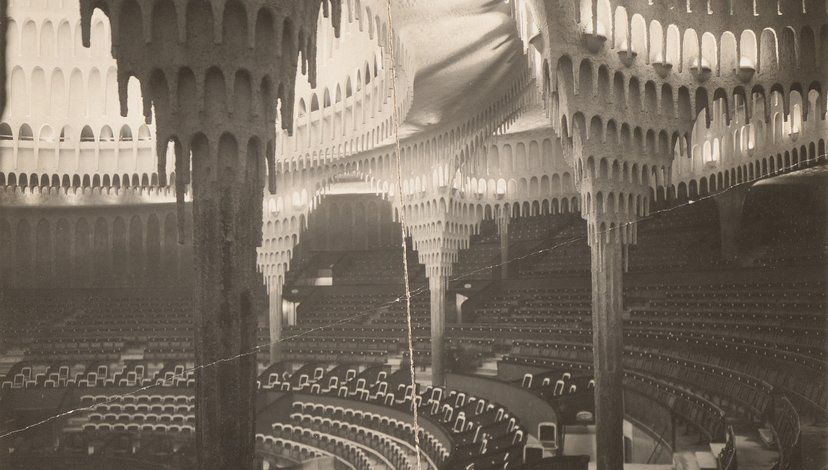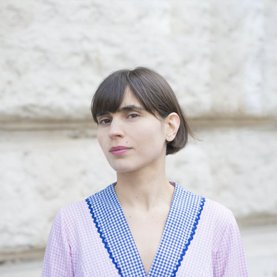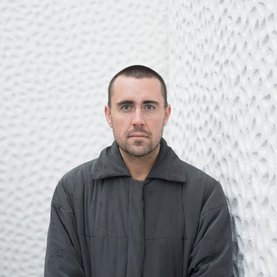ADS12: Limits
Jump to
Studio Tutors: Pa.LaC.E: Valle Medina & Benjamin Reynolds

Theatre as a lawless space; the site of violent acts, absurdity and extreme emotion. Hans Poelzig’s Großes Schauspielhaus (1919), Berlin, Germany. Cavernous and red, the stalactite-columns replaced a market, and later played host to a circus.
In 2021/22, the projects of ADS12 enacted promises of strategic omissions, wilful refrains and absences. Instead of perpetuating the view that architecture conflates acts of removal and reduction with aesthetic norms, we explored the productive potential of loss, development without growth, and the possibilities of whether deprivation can open new viewpoints. This year, we will deal with limits of experience as a means to discover the boundaries of our human senses. The notion of ‘limits’ implies the shift from the known and ordinary to the unknown and extraordinary. A transit that we will seek to unearth novel relational patterns between the participants in the studio and nature. By producing in extremis spatial and ambient scenarios, the studio will ask new questions about our existing behaviours and architectures?
Ecstasy and Horror
For millennia, artists and writers have sought out the far reaches of human experience. The seductiveness of such extremities also led to astonishing architecture. The marriage of boundless ambition and technical prowess resulted in exalted historical examples like the Hagia Sophia, the epitome of Byzantine architecture, which was once the largest interior space in the world.

Hagia Sophia, Istanbul in 1971 (537 AD). Its interior, covered by a dome spanning 32-metres resting on pendentives (L)(R). Source: BU International Center for Eastern Asian Archaeology & Cultural History.
Later, after the identification of extreme experiences, came the advent of philosophies that would explore what it means to live at the edge of limits. Due to the development of written and painted mediations on reality, frameworks were developed that expose the limits of our thoughts and conjure up the moment in which language breaks down. The rupture of reality through intense experience revealed that the climax of pleasure is not only purely pure pleasure alone, but one that is intermixed with danger, fear or even pain. (As Georges Bataille offered.) This year, we will explore how an experience of divine ecstasy and extreme horror can be identical. In ‘Limits,’ we will create a collective space for the generation of such knowledges at the boundaries of our thinking.

The obsession of visualising extremes of human emotions: Mary Magdalen in Ecstasy (1606), Caravaggio (L), Laughing Demon (1831), Katsushika Hokusai (R). Source: La Repubblica and hokusai-katsushika.org.
Thresholds and Lines
At what point is a limit a violation? In ‘Limits’ we will host lively discussions around the classification of limits and set collective boundaries as a group. In doing so, we will discover the subjective nature of limits and the challenges reaching a consensus entails. By exposing ourselves to real-world ecstatic/horrific extremes – such as nature v. torture, mysterium tremendum v. political realism, the afterlife v. near-death experience, cornucopias v. market forces – sketches will be developed that detail the things we can or cannot tolerate, strategies on group-empathy and coping mechanisms. ‘Limits’ will also draw parallels from the material of architecture, considering, for example, the distinction between thresholds (as a gradient of limits) as opposed to lines (a hard limit).

Tendai Buddhist monks (L)(R) in Japan experience four so-called ''Hells", one of the most demanding physical and mental challenges in the world. 1. the Cleaning Hell: a minimum of six hours a day cleaning Enryakuji Temple (C); 2. the Chanting Hell: total isolation indoors chanting and meditating; 3. the Walking Hell: a marathon of 1000-days on Mount Hiei outside Kyoto. Only 46 people have completed it; and, 4. the ultimate hell: a twelve-year solitary mountain retreat. Source: The Marathon Monks of Mount Hiei, John Stevens.
Sentience and Foolery
As sentient beings who are capable of emotionally processing our surroundings, we first experience physical events through our own bodies – the proximity to a wall, climbing a cliff, walking in the dark. Eighteenth–century empiricists argued it was through our sensorium that we first accumulate information in order to then be able to describe it through language. But how are experiences transmitted? And what is it like to sense virtually? Is the technification of experience dominating our senses and limiting experience?
To interrogate these questions we will modulate our own perceptions. By making objects larger than they are (macropsia and micropsia), nearer or further (pelopsia and teleopsia), or presenting them as altered shapes (metamorphopsia), we will aim to fool our relationship to the physical environment and destabilise experience.
Drama Saturation
Bewilderment – as the confusion arising out of a failure to understand – often occurs in theatre. Within the confines of theatre, we can explore the limits of human drama and observe behaviour that would otherwise be obscene, or outlawed. The theatre remains a lawless zone for the simulation of violent acts, absurdity and extreme emotion. Using theatres as a beginning point – a ‘root space’ – for the project, the studio will use the potential of theatre as the site of experimental human drama and purposefulness.

Arranged as a waiting room, Gucci's FW18 show mocked an operating theatre (L); During the same show several actors walked around carrying a replica of their own heads (R). Source: highsnobiety.com
Encircling Rooms
Space itself is only formed by limiting it. As a surface designed to protect us from weather, even a ceiling elicits psychological impact. It regulates brightness via zenithal apertures – portals, holes, punctures – and has been the bearer of legends in frescoes and reliefs. Likewise, walls have protected us from the gaze of the Other. And windows, doorways and bridges can both limit space and act as a hinge to the outer world. What occurs when other non-physical phenomena are employed to curb space? In ‘dark retreats,’ unlit spaces further spiritual practices in Buddhism. Diminished levels of oxygen in hypoxic chambers help prepare athletes for high-altitudes through their consensual suffering.

The cabin as the rationalists utopia. Capocotta Cabin, Capocotta (Rome), Italy in 1965 by Julio Lafuente (L), The ceiling is the stage, Garrick Theatre at the Schiller Building by Adler and Sullivan in Chicago (1890-1892) (R). Source: Pinterest and countryliving.com
Limit–Stages
It was recently found that, on average, we exchange verbal language at an information density of 39 bits per second. A case can be made that this is the biological limit of communication. Some languages, which have lesser information density, such as Spanish and Japanese, are spoken quickly. By contrast, high-density information languages such as Thai, Vietnamese are spoken slowly. Could an architectural record – composed by layering scales, geometries, time, lineweights, linetypes and depth – become a testimony to the limits of documentation of real-world/virtual construction? Within ‘Limits,’ we will move beyond conventional modes of representation in order to imagine and create alternative forms of perception and sensuality, which transform dominant visual and ideological assumptions. Ultimately, we hope to uncover the limits of our thought, shake us out of our prejudices, and look at things with new eyes.

The limit of comprehension. SUPA Architects, Naked Plan House P Drawing, 2015. Digital drawing. Courtesy: SUPA Architects. Source: drawingmatter.org.
Epistemic Treasures
There was a moment in human history when what was transcribed was meant to contain the entire knowledge of the world at that point. Hugh St. Victor’s Mystic Ark captured the entire cosmos – a mappa mundi, the zodiac cycles, Roman calendar, systems of periodisation and weather, geography and so forth. The Ark was the meeting of Hugh’s encyclopaedic curiosity with a mediaeval Paris teeming with Greek manuscripts via the Arab world.
Is it possible to create a spatial document at the limit of our episteme? What emerges when our creations are impervious to standards and values? What will result if we engage in acts of making for the sake of pure expenditure, or wastefulness? It may be that our vision may encase the entire world and therefore become a riddle of sorts. However such endeavours do not preclude concrete projects. The limit of knowledge is also tied to those who are often termed a ‘Living Human Treasure.’ An individual capable of passing vast amounts of knowledge to the generations, like a Japanese Kyogen master. Such knowledge is active, unrecorded, and confined within the limit of the body. In ‘Limits,’ we will imagine the absence of the archive, book, record or storage media. In its place, we will create forms of recording experiences that are encoded, embodied and performed. To this end, each studio participant will create a ‘Limit-Stage’ as the basis for their project, and which will link digital and physical processes, biological and material conditions. There will be an emphasis on physical experimentation and the production of large works in order to examine how spaces can be conceived under extreme scenarios.

The map as the limit of the episteme: Persian author Manṣūr ibn Ilyās’s Tashrīh-i Manṣūrī (1396), the first illustrated anatomical treatise (L),Tablet, Nippur, Iraq, ca. 1500 BCE, CBS13885, among the first ever urban maps (R). Source: Wellcome Collection and Penn Museum.
High Holdings
Our Live Project will involve a series of conversations at Eileen Grey’s iconic E-1027 house. We will be joined by a series of invited guests, who – like participants – will respond to themes of the house as a theatrical stage. This project will engage with the (re-)enactment of histories and the propagation of myth and lies.
In 2022/23, “Limits” will again be hosted within High Holdings (http://ho.ldin.gs/) – an environment for the generation of architectural discourse. High Holdings addresses the unfolding depictions of the world that may appear unrecognisable, but are truly products of terrestrial occupation. By prioritising the sovereignty of the architectural idea, High Holdings continues to explore the growing distance between information and (over-)looking; complexity and (mis-)understanding; contribution and (non-)participation. Previously, “Take-away” (2021/22) explored deprivation as a productive strategy; “Melee” (2020/21) developed projects as plenitudes, “Sight/Seeing” (2019/20) put the conspicuity of the Image on trial and “CHRONOCOPIA” (2018-9) explored how to characterise time within the architectural project in order to perceive the speed of the present.

